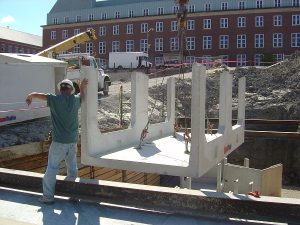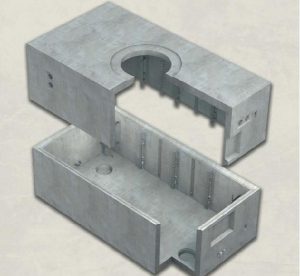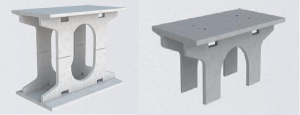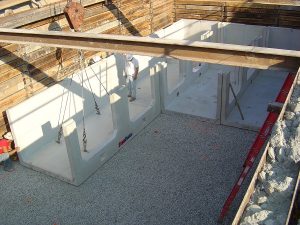
On the last day of our construction materials manufacturing tour, we had left Indiana early in the morning and headed towards Morris, Illinois; the main office of the Utility Concrete Products, LLC, (UCP) (www.utilityconcrete.com). Upon arrival, we were welcomed into the conference room by Mr. Philip J. Burkhart, Vice President of UCP and inventor of StormTrap®.
UCP’s roots trace back to the 1970s when telephone companies were going through a revolutionary change in underground telephone wire distribution. The first precast item produced by UCP was the 12’-0” x 6’-0”x 7’-0” Type “A” Manhole as shown below. As of today, there are 15,000 of these manholes in the Milwaukee and Chicago area housing copper wire splices. One significant advantage of using these types of manholes (and precast in general) is that there are very minimal time delays in the installation process.

After the success of the “Type A” Manhole, the engineers at UCP devised multiple manhole designs which are provided in great detail in their catalogue which is available on their website (http://www.utilityconcrete.com/catalog/manholes/).
Most of the products produced by UCP typically use type I or type III cement. Furthermore, UCP is a proponent of self-consolidating concrete. All of their products, regardless of whether they are above ground or below ground, use this unique type of concrete mix. The compressive strength of most of their products is within the normal strength concrete range.
Another underground product introduced to us by Mr. Burkhart was his invention, StormTrap® (www.stormtrap.com). StormTrap® comes in two configurations, the SingleTrap® (as shown by the image on right) and the DoubleTrap® (as shown by the image on the left).

The idea for this unique invention had come to Mr. Burkhart in order to address all the EPA regulations associated with storm water runoff. Mr. Burkhart had created this product about 15 years ago. The latest configuration has received the Creative Use of Concrete (CUP) award from the National Precast Concrete Association (NPCA). Most of the StormTrap® products could be found in urban areas and one great advantage of this product is that it generates minimal waste. Furthermore, this precast underground product also uses self-consolidating concrete.
Amongst the above ground products, one of their most popular items is the IDOT concrete barrier as shown below. There are approximately 25,000 of these barriers in the state of Illinois.

Once Mr. Burkhart had familiarized us with a general idea of UCP’s product line, we entered the precast plant where we met our plant tour guide Mr. Jamie Hawken, General Manager of Utility Concrete Products. The precast plant spanned about 96,000 s.f. (400 ft x 240 ft). The plant was divided into three 80 ft bays. Each bay served a different purpose. One was filled with precast sound barrier walls and its associated equipment, one was filled with StormTrap® products and its associated equipment and the other was filled with the raw materials/ formwork used for the precast products.
The highlight of the precast plant was the sound barrier walls (as shown in the image below). UCP produces unique sound barrier walls that have both absorptive and reflective qualities. This phenomenon was accomplished by applying a very thin layer of a material called Soundsorb®, onto the finishes of a typical sound barrier wall. Our group was fortunate enough to see how the concrete mix gets poured into the formwork as well as the end result of a typical Soundsorb® sound barrier wall.

To top it all off, Mr. Hawken demonstrated a typical QA/QC test for self-consolidating concrete. As opposed to the typical slump test, for self-consolidating concrete there is a “J-ring” test and flow test used to measure the workability.
Thank you UCP for giving the Global Leaders a very thorough and enjoyable insight to the precast industry!

